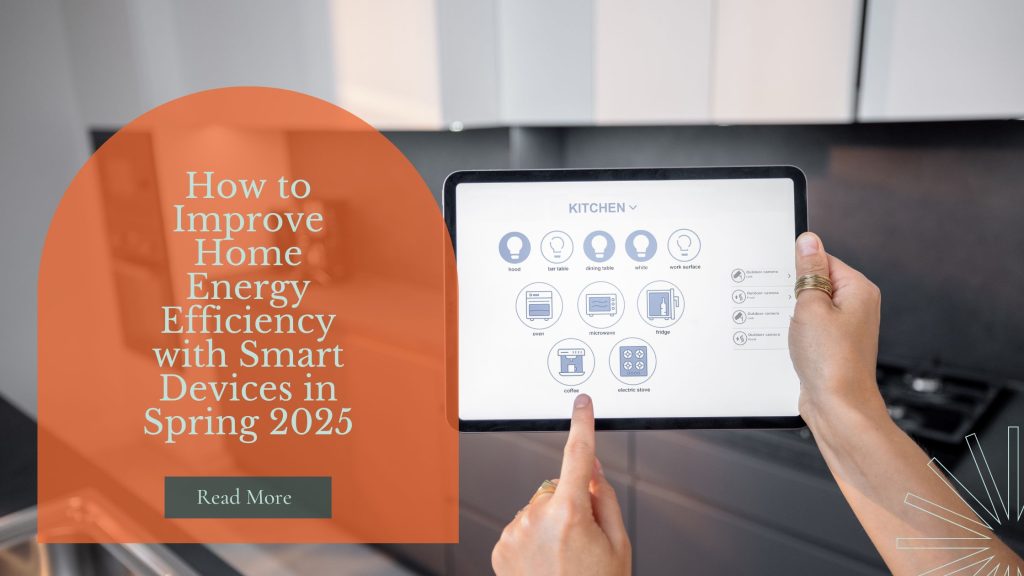As temperatures begin to shift and days grow longer, spring is the perfect time to assess your home’s energy use. Thanks to advances in technology, homeowners now have a wide range of smart devices that can cut costs, reduce waste, and improve comfort—all while being environmentally friendly. Whether you’re trying to upgrade your space or lower your bills, 2025 offers some of the most effective tools yet for smart home energy efficiency.
Why Spring is the Best Time to Boost Your Home’s Energy Efficiency
Spring strikes the ideal balance between extreme cold and intense heat. That makes it a prime season for evaluating how your home uses energy and where it may be leaking it. It’s also the season most people begin deep-cleaning, decluttering, and renovating—so why not include smart home energy efficiency in that mix?
Unlike winter or summer, you’re not battling constant HVAC usage, making it easier to notice the subtle shifts smart devices can create. Plus, utility costs tend to spike in the summer, so making changes in the spring ensures you’re ready ahead of time.
Top Smart Devices to Lower Your Energy Bills in 2025
Today’s smart tech isn’t just about convenience—it’s about control. And when it comes to managing how much power your home consumes, the best smart devices for energy savings in 2025 have never been more advanced.
- Smart thermostats 2025 models feature predictive learning, voice activation, and compatibility with solar energy systems.
- Energy-efficient smart lighting systems adjust brightness based on natural light and room occupancy.
- Smart plugs for energy conservation give you insights into which appliances draw power unnecessarily—even when turned off.
- Whole-home energy monitors track usage in real-time and make tailored recommendations for cutting costs.
All these tools work best when used together, creating a connected ecosystem that optimizes every corner of your home.
How Smart Thermostats Can Help Save Energy This Spring
Among all smart home devices, thermostats are still the front-runners for saving energy and money. The newest smart thermostats 2025 come with features that go far beyond simple programming.
Instead of manually setting your desired temperature, these devices learn your daily routines, factor in weather forecasts, and even adjust based on the number of people in a room. Some integrate with occupancy sensors or your smartphone’s GPS to determine when you’re away—and adjust accordingly.
What does that mean in real numbers? You could see up to a 20% reduction in your heating and cooling costs. That’s a big win for both your wallet and your carbon footprint.
Moreover, if your HVAC system is aging or inefficient, a smart thermostat can alert you to unusual patterns or suggest when it’s time for maintenance. This proactive approach not only improves smart home energy efficiency but extends the life of your equipment.
Smart Lighting Solutions for a More Efficient Home
Lighting accounts for nearly 15% of an average home’s electricity usage, which adds up quickly. But upgrading to energy-efficient smart lighting can bring that number way down without sacrificing ambiance or style.
The latest systems in 2025 feature adaptive brightness, motion sensing, and geo-fencing capabilities. Lights turn off automatically when no one’s around or dim during daylight hours, saving energy with zero effort on your part.
Smart bulbs also last longer—many up to 25,000 hours—so you’ll change them less frequently. Even better, they often sync with home assistants like Alexa or Google Home, giving you voice control over lighting schemes.
Want to boost mood lighting for a dinner party or wind down with dim hues in the evening? It’s all programmable via your phone. That’s the magic of energy-efficient smart lighting—it’s stylish, cost-effective, and automatic.
Using Smart Plugs and Appliances to Conserve Energy
Not all appliances are energy hogs—but many still draw power even when they’re turned off. That “phantom load” can account for up to 10% of your electricity bill. Luckily, smart plugs for energy conservation help address this silent drain.
These clever devices monitor how much power individual outlets use and give you complete control over when devices are on or off. You can schedule them to shut down overnight or when you’re not home, cutting off electricity to things like coffee machines, TVs, or gaming consoles.
Pair smart plugs with energy-efficient appliances, and you have a powerhouse combination for saving energy. Many newer appliances, like refrigerators or washing machines, now come with built-in Wi-Fi, allowing you to monitor cycles, reduce power during peak hours, or run them at optimal times.
And don’t forget about energy monitors. They give a full overview of your household consumption, highlighting trends and offering suggestions—some even integrate with solar panels and battery storage systems.
With these tools, smart home energy efficiency becomes less about guesswork and more about data-driven action.
Final Thoughts
Improving your home’s energy profile in 2025 doesn’t require a full renovation or complex tech knowledge. Small changes—like installing a smart thermostat 2025, upgrading to energy-efficient smart lighting, or using smart plugs for energy conservation—can lead to major long-term savings.
By choosing the best smart devices for energy savings, you’re not only lowering your utility bills, but also taking steps toward a greener, smarter lifestyle.
And there’s no better time to start than spring—when nature is in renewal, and your home can be too.



